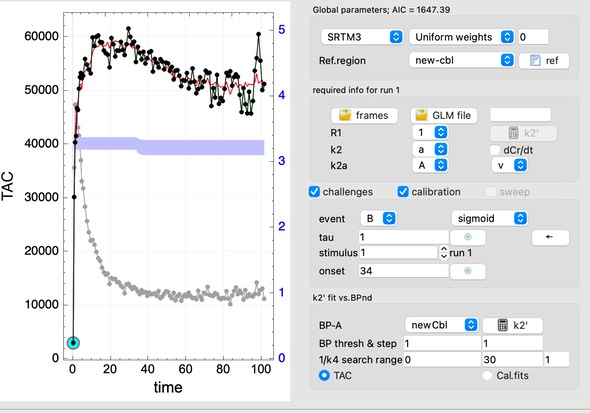The prototypical reference tissue models (RTM) is the multilinear reference tissue model (MRTM), which may be reduced from 3 to 2 parameters (MRTM2) by fixing the reference tissue efflux parameter k2’. To include the option of a within-scan challenge, one can add an additional term to represent a time-dependent change in the parameter k2a. This model combines methods described in Ichise 2003 and Alpert 2003.

Kinetic models that are available by default in fastmap include MRTM3 (3 parameters + challenge), MRMT2 (k2’ is fixed), and forward models fFRTM3 and fFRTM2, which use fixed global values of k4. To convert from 3-parameter to 2-parameter models (e.g. MRTM3 to MRTM2), load a high-binding ROI (overlay) and click the k2’ calculator button. For all RTM variants, the reference region is selected from the set of pre-defined overlays, so an overlay list must be loaded. Sometimes PET data is smoothed, which potentially can corrupt the reference region. In this case, the raw region data can be written to the frames table file as separate column using a GUI button, and then selected from the “overlay list” as the reference region when the smoothed data is analyzed.
MRTM is implemented using identical methods to other GLM time-series analyses in fastmap, so baseline parameters (e.g., k2, k2a) can be fixed or made variable across runs in the same session (e.g., baseline + blocking scan). Common shapes for within-scan challenges are sigmoidal (a change of state of BPND with a variable time constant) or a gamma shape (a transient change in BPND). Uniform weights are suggested for MRTM. Weighting models based upon counting statistics are implemented, but these models generally emphasize the initial uptake part of the time-activity curve, which has low signal fluctuations but also most strongly violates the fast-exchange approximation underlying SRTM (in which k4—>infinity).
For mapping, MRTM2 is more robust than MRTM and should be used. Region-of-interest “mapping” is enabled in fastmap but generally should be discouraged for exploratory applications, because ROI-methods disguise bias in ways that voxel-wise methods do not. Both MRTM and MRTM2 are not particularly accurate for changes in occupancy below 10%, at least when using within-scan challenges, because they employ the SRTM fast-exchange approximation. MRTM is a pseudo-GLM method, in that regressors are derived from noisy data and therefore, in principle, suffer from regression dilution and invalid identifiability based upon goodness of fit criteria. Experience suggests the former problem is minor in comparison to the fast-exchange approximation, whereas the latter problem can be a concern whenever MRTM-based models are compared to alternative models with less noisy regressors. Nevertheless, for a wide variety of applications, MRTM/MRTM2 can be a powerful and robust method that avoids arterial blood sampling.
An alternative to SRTM/MRTM methods is a forward full reference tissue model (fFRTM) that avoid the fast-exchange approximation (1/k4=0) in favor of a global value of 1/k4 that is representative of the radioligand. For fFRTM, k4 can be determined from a single time-activity curve using the top k4 calculator button, or from a series of BPND-dependent regions using the bottom k4 button.